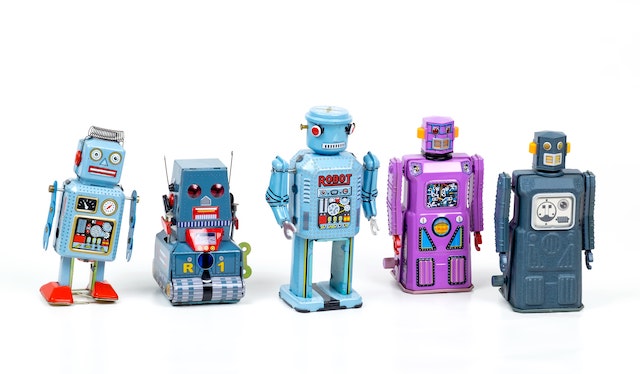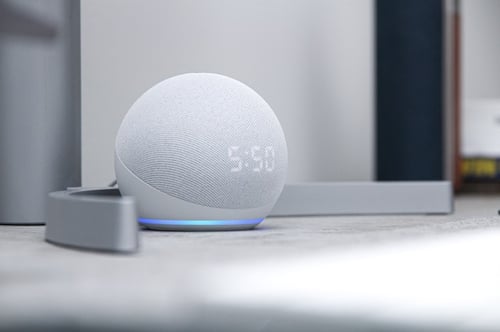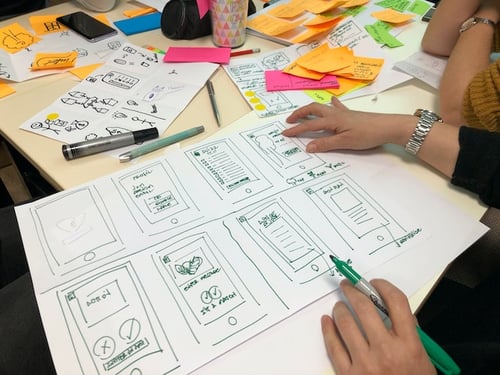
Here, we’ll explain what chatbots are, how they’re used, and why they’re an excellent addition to any business’s customer service operations. We’ll also take a closer look at the different types of chatbots in the market today—from simple FAQ - driven customer self-service service chatbots to AI - powered virtual assistants—and showcase some of today’s best chatbot examples. Finally, for those of you ready to get on the chatbot bandwagon, we’ll offer a few tips for how you can build your own customer chatbots from scratch.
Table of content
- What is a chatbot?
- Different types of chatbots
- What are chatbots for and why are they important?
- Best chatbot examples
- How to build a chatbot?
- Improve the customer experience with Smart Tribune
What is a chatbot?
A chatbot is an automated and highly interactive conversational tool, typically powered by artificial intelligence (AI) and machine learning, that responds to questions in either written or verbal form. These conversation-based tools can perform tasks varying in complexity, from answering simple FAQ-oriented questions to helping customers conduct transactions like opening a bank account, booking airline tickets, and following up on a customer service request.
Chatbots are an easy and intuitive way to enhance your customer service by removing roadblocks at virtually every step along the customer journey. According to LivePerson, 90% of consumers are more likely to do business with companies that answer enquiries immediately, further positioning chatbots as a simple way to make great customer service accessible 24/7.
This is just one of many reasons why the chatbot industry is growing with each passing year. In fact, the industry’s value is expected to reach $10.5 billion globally by 2026, a direct result of 31% of the world’s top-performing companies saying that they plan to use AI solutions, such as advanced chatbots, to improve the customer experience within the next 12 months.

How do consumers feel about chatbots?
Even though chatbots are a relatively new way to deliver real-time customer service, compared to making a good, old-fashioned phone call or even sending an email, they’ve become increasingly popular over the years as a first-line-of-defense for asking questions or getting a customer service interaction started. Sixty-nine percent of consumers prefer using chatbots to answer questions like ‘How do I book a consultation?’ and other simple enquiries.
Research carried out by Drift in 2019 revealed that 35% of people use chatbots to resolve a problem or for getting a more detailed answer. The same percentage of consumers also mentioned they’d like to see more companies offering chatbots as a customer service channel.
Fortunately, it seems as though reality lives up to the hype of chatbots, as 80% of consumers say their experiences with chatbots have been positive. So positive, in fact, that 27% of consumers would be happy to transact or purchase basic items directly through a chatbot interface.
How long have chatbots been around?
Surprisingly, the technology behind chatbots has been around since the 1950s. ELIZA and the Turing Test, created by Joseph Weizenbaum and Alan Turing, respectively, laid the foundations for modern chatbot technology. ELIZA, for example, was a programme designed to imitate a therapist. Even though it only knew 200 lines of text—and users were well aware they were chatting to a machine—it proved to be effective for some.
Though these early conversational technologies were quite basic and very limited in their capabilities at first, major tech companies, such as Apple, Google, and Microsoft, were able to build on them to create products and services that are now part of the fabric of daily life.
Why were chatbots created in the first place?
As smartphones came into mainstream consciousness in the 2000s, web content was suddenly forced to be condensed onto a much smaller screen. Developers needed to find a new way for users to access information without simply packing it in.
Apps were touted as the future, but we’ve come to learn that they’re not always what consumers want. For instance, Comscore found that 78% of smartphone users engage with less than three apps. A new way to engage with the online world, one that could side-step clunky interfaces not optimized for mobile use, was needed.
Chatbots, particularly AI-based virtual assistants like Alexa and Google Assistant, open up a world of possibility to users who don’t want to download yet another app. This could include everything from getting the latest local weather forecast to listening to music and podcasts on-demand or from controlling in-home lighting to managing to-do lists and schedules. Today, the advanced technology underlying chatbots has essentially been able to automate the end-to-end consumer experience in myriad ways, whether people actually realize it or not.

What are the different types of chatbots?
All chatbots are driven by programmed rules and natural language processing (NLP), with some powered by more advanced machine learning and AI algorithms. Today, there are two primary types of chatbots that you should be aware of:
- Declarative Chatbots: Also known as ‘task-oriented chatbots,’ this is the most basic iteration of a chatbot and, consequently, also the most commonly used. But don’t be fooled, even basic chatbots rely on some pretty clever coding.
These chatbots use rule-based programming to answer straightforward questions accurately. In short, the interaction looks something like this: If a customer asks X, then the chatbot does Y. To get there, both natural language processing, which can only understand input words in a very literal sense, and machine learning-powered decision trees, that attempt to predict what the consumer actually needs based on past learnings, must work together to surface the most relevant answer to a question. - Conversational Chatbots: Conversational chatbots, like Google Home, Alexa or Siri, take natural language processing one step further by moving it into the realm of natural language understanding (NLU). These chatbots are able to understand the context and intent behind the user’s words and generate a semantic analysis, which basically means it can interact with people in a more sophisticated, relevant, and, as the name suggests, conversational way. These AI-powered virtual agents continue to learn as they go, getting better at both understanding and predicting what people want to get in return for the questions they ask or the commands they give.
How do chatbots work?
Although there are two types of chatbots—declarative and conversational—in the market today, there are a lot of different use cases for how consumers can interact with them.
Webpage chatbots, for example, typically take the form of a pop-up text box or clickable icon somewhere on a business’s website. These allow customers to communicate with a helpful robot at any point along the customer journey via text input. Virtual assistants and agents, on the other hand, need to be spoken to. Without so much as a click of a button—and sometimes just calling the device’s name—smart technologies like Alexa, Siri, and Cortana will leap to your aid, whether you need a beef bourguignon recipe or plane tickets to Miami.
Some IOT devices also have chatbot functionality built in, which makes it possible for people to interact with them via voice commands. Although this technology is still in its infancy for integration into mass market consumer products, in the not-too-distant future we could conceivably own ovens that can begin preheating in response to a simple voice command.
What is the best chatbot for your business?
The best chatbot for your business will depend on what you actually need it to do. Sometimes, a basic FAQ-based chatbot that can easily weed out and address simple tier-1 customer service enquiries—those that don’t require human intervention—is all your business needs.
However, if your business produces more complex products and services—or if a large number of your customer service enquiries can’t be resolved with basic FAQ information alone—then you may need to invest in a more advanced chatbot solution that can help your customer service team triage customer questions more effectively.
Either way, when used as a tool to enhance your customer service offerings—and bring your business into the age of customer self-service—a smart chatbot can go a long way towards boosting customer happiness and satisfaction at every step along the entire customer journey.
By being able to automate the responses for up to 70% of simple customer questions, chatbots can also free up customer service agents’ to focus their attention on complex customer needs.
What do you need to create a chatbot?
Unless you’re seriously tech-savvy, you probably won’t be creating a chatbot from scratch anytime soon. But before you begin the process of building a chatbot, you need to ask yourself the following questions to ensure that whatever you create aligns to your business’s needs:
- What kinds of functions do I need my chatbot to perform?
- Will the chatbot only be able to answer a series of clearly defined questions?
- Will the chatbot be able to direct people to where they can find answers on their own?
- Would a live chat function be better?
- Should the chabot redirect a conversation to an agent if it can’t answer a question?
- What is the conversational flow or script that your chatbot will need to follow?
- How will customers input their queries? Will they type? Will they click buttons based on prompts provided by the chatbot? In other words, what is the user experience?
- Will chatbot appear as a pop-up box that can follow customers as they navigate your website or will it only live on a dedicated “Help” section of your website?
What are chatbots for and why are they important?
Chatbots have lots of uses. But they’re most commonly used in a customer service capacity, giving visitors to your website a quick and easy way to get help or access product or service information 24/7—even when your customer service agents have clocked off for the day.
In this customer service capacity, chatbots have a lot of benefits, including:
- Offers around-the-clock customer service support
- Provides a personalized customer experience (based on the information within a customer’s profile information or past purchase or browsing habits)
- Supports automating simple tasks and transactions
- Reduces customer case cost (ROI)
- Create a better, more conversational customer service experience
- Removes roadblocks across the customer journey to increase conversions
- Boost agent productivity by reducing overall enquiry volume
As a starting point, many businesses use chatbots to automate responses to basic questions around a business’s operating hours, shipping options, return and refund policies, and so on. By providing quick and easy answers to these questions—which make up about 70% of enquiries received by customer service teams today—agents are no longer bombarded by these simple requests and, instead, can devote more time to complex customer issues. This can have a direct impact on long-term customer satisfaction, loyalty, and happiness.
In fact, when AI-powered chatbots are woven into a business’s customer service operations, Salesforce found that 64% of customer support agents have said they are able to spend most of their time solving difficult cases. Research by Outgrow also revealed that 56% of customers prefer to message or interact virtually with customer service teams versus talking on the phone.
Today’s best chatbot examples
Chatbots have become fairly ubiquitous in the digital customer experience. Here are three chatbot examples that show off their true potential in shaping and improving customers’ lives.
1. Alexa
With more than 40 million daily users in the US alone, Amazon’s Alexa has become one of the best-known names in voice-based digital assistants around the world. Now available on a wide range of devices, including Amazon Echo and other iOS and Android devices.
In response to a user’s simple voice command, Alexa can play music, answer search queries, book flights, and even shop online. About 70% of smart home device users in the US have an Echo, with 10.8% of online purchases being made directly via Alexa in 2020. It’s not surprising, then, why voice bots are quickly becoming the future of customer service.

2. Siri
Launched alongside the Apple iPhone 4S in 2021, Siri was the first digital assistant to have a voice. And she’s come a long way since then. At first, the biggest benefit of Siri was to answer simple questions like, “What’s the weather like today?” in response to a voice command. Now, Siri can send texts, read your emails aloud, make restaurant suggestions (and reservations) based on your location and the time of day, help you purchase goods, and so much more.
3. Meena
Google’s newest AI chatbot, Meena, is a powerful conversational chatbot. It has been trained using a whopping 341 GB of public domain text and scores incredibly highly on the Sensibleness and Specificity Average (SSA)—a way to test how close to resembling a real human conversation an AI chatbot can actually get. Though Meena hasn’t been released yet, it promises to be one of the most realistic and advanced chatbots available to-date, scoring 23% higher than Mitsuku (another industry leader) on the SSA scale and just seven percent below actual humans.
How to build a chatbot
If you’re ready to launch your own customer service chatbot but not quite sure where to start, here’s a quick checklist to help get the ball rolling:
- Appoint a project manager: This should be someone from the customer service or customer experience team, as they understand customer needs better than anyone else.
- Build a knowledge base: This includes FAQ content, internal scripts or frameworks that your customer service team uses to handle customer calls and emails, and other resources that address common customer enquiries. Check out this great article on the basics of creating and managing a knowledge base.
- Prioritize: Be sure to address the most common customer needs first, like ‘how to return an item.’ More complex responses to in-depth customer enquiries can be built in as you go—and can sometimes even be learned by chatbots through machine learning—but covering the basics in the beginning will ensure you address the most pressing customer needs first while also reducing customer service team contact volume.

- Focus on one language at a time: Although you may operate a business that engages with customers who speak multiple languages, be sure to focus on the most dominant language first—whichever is spoken by the majority of your customer base—and then iterate from there. This will give your chatbot a better chance of providing immediate value the minute it launches.
- Be clear about your chatbot’s limits: Being upfront about what your chatbot is capable of doing—and when it needs to pass the conversation along to a living, breathing human being—will minimize frustration for customers and customer service teams alike.
- Build an on-brand chatbot: If your brand is upmarket and refined, a chatbot that communicates solely in gen-Z slang will stick out in the worst way. Make sure everything about your chatbot, from its name to its language to its appearance, reflects your brand’s identity and values. This is one of the reasons why the team at Smart Tribune believes that there’s no such thing as one-size-fits-all when it comes to chatbots.
- Continue training, developing, and optimising: Don’t rest on your laurels once your chatbot is up and running. Constantly feed your chatbot new data and information to ensure it’s capable of addressing real customer needs in real-time. Also, be sure to run benchmark studies to ensure that your chatbot is keeping pace with your competitors.
How can I create a chatbot myself?
If you don’t have access to a skilled developer and are lacking the digital skills to do it yourself, there are a number of online tools that can get you moving in the right direction:
- Hubspot: If you’re on a budget, Hubspot’s chatbot builder is a great option. You can easily customise your bot, even if you don’t consider yourself to be tech savvy. The only hitch is that you must subscribe to Hubspot’s Sales Hub service to access this tool.
- MobileMonkey: This free service can help you build a simple, out-of-the-box chatbot that integrates into Facebook Messenger and can do everything from making appointments to tracking keywords to building your customer database.
- Botsify: You can operate up to 100 AI-based chatbots—and service up to 50,000 users— across multiple conversational channels using Botsify’s software.
- Smooch: This service helps bring all of your notifications in one place, whether they come from Slack, Trello, or Facebook, making it easier to keep an eye on how people interact with your chatbots, so you never miss an opportunity to step in and offer help.
Now, if you really don’t know where to start, we’ve put together a list of 8 questions to ask before launching your chatbot. Or, you could simply reach out to our team of customer self-service experts.
Improve the customer experience with Smart Tribune
As you can see, there’s a lot to consider before launching your very own chatbot. While building a chatbot may sound complicated—because, after all, there are a lot of moving parts to ensure it works according to spec—this user-friendly digital customer service solution can be an efficient and cost-effective way to improve the customer service experience, empower customers to be autonomous across the customer journey, increase conversions, boost customer satisfaction and loyalty, free up customer service agents to tackle tasks requiring human intervention, and so many other benefits to the customer experience.
Ready to build a chatbot for your website? First, be sure to brush up on our checklist for launching a chatbot. And if you don’t have the time or the right tech skills on-hand to tackle this task in-house, reach out to our team to learn more about how Smart Tribune’s customer self-service solutions can propel your business into the future of customer service.
Schedule a demo today to start building a customer self-service chatbot of your own.



.png)



